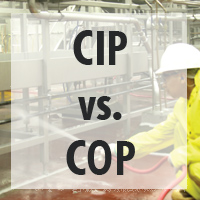Tip of the Week: CIP vs. COP

Clean-in-place (CIP)/ Clean-out-of-place (COP) systems are important in the way manufacturers sanitize and clean their facilities. However, it is highly important to have skilled operators to handle both systems to ensure effective cleaning.
Explaining the Difference
COP systems are used to clean small pieces of equipment that wouldn’t be touched by a CIP systems. These includes: fittings, clamps, product handling utensils, tank vents, pump rotors, impellers, casings, hoses, etc.
CIP systems clean and sanitize hard to reach interior surfaces of process equipment and structures. These systems are used in bakeries and milk processing facilities. These are areas that are hard to see with the naked eye and the long brushes can’t be used to clean these areas. This equipment is not limited to tanks, pipes, and pumps.
@@CIP system are usually faster than manual cleaning@@, less labor intensive and no disassemble or reassembly required.
Inspections of the CIP system can produce highly repeatable results if handled by skilled operators. These inspections can be documented. Worker safety is another benefit of CIP systems as they provide less chemical exposure. These systems help workers effectively manage water and chemical costs. The only downside is that CIP systems have a high initial cost.
COP systems usually have lower investment costs than CIP systems. With a COP system, the results are consistent and provide a cost savings over manual cleanings - saving time, chemical, and water usage. COP minimizes operator exposure to high temperatures and strong chemical concentration. Unfortunately, COP is manually intensive because of disassemble, reassembly, and loading/unloading the COP washer.

